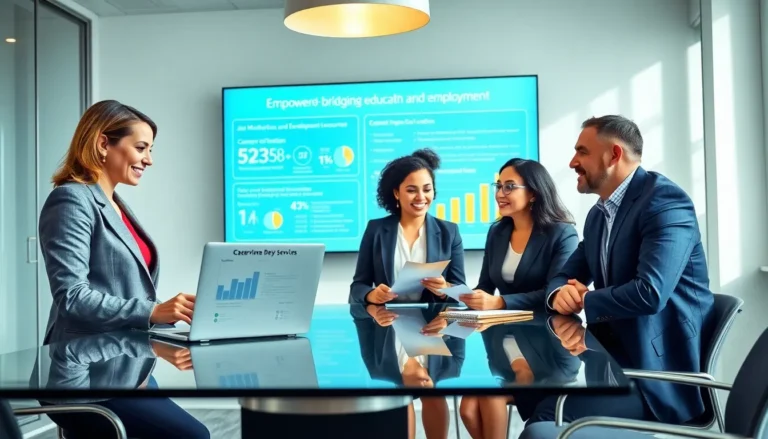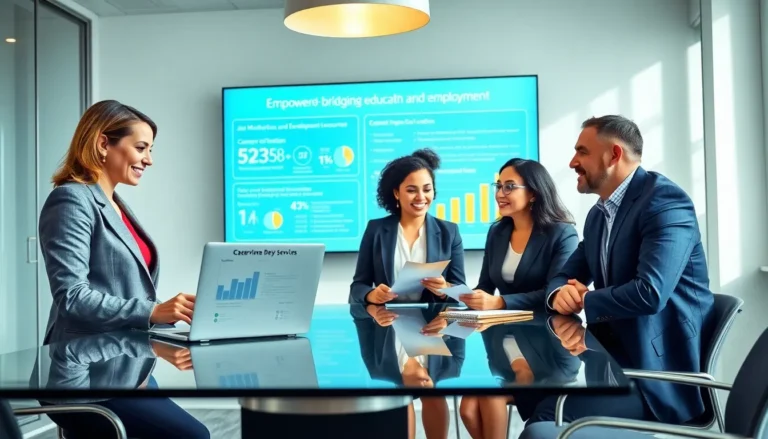Table of Contents
ToggleEver tried watching an Android video on an iPhone and felt like you were peering through a foggy window? It’s like trying to read a menu in a dimly lit restaurant—frustrating and slightly ridiculous. But fear not! There’s a way to transform those pixelated masterpieces into crystal-clear gems that’ll have you wondering if you’ve stepped into a new dimension of video quality.
Understanding Video Formats
Video formats play a significant role in the playback quality of videos across different devices. Understanding these formats helps in addressing clarity issues when viewing Android videos on an iPhone.
Common Video Formats Between Android and iPhone
Both Android and iPhone support various video formats. MP4 stands out as the most widely compatible format, working seamlessly on both platforms. Another common format is AVI, though it may require additional applications for playback on an iPhone. Additionally, MOV, originally designed for Apple products, offers excellent quality but might not play on older Android devices. Recognizing these formats aids in selecting the right video files for optimal viewing.
Compatibility Issues
Compatibility issues often arise due to variations in video codecs and container formats. Different devices may process these formats differently, causing playback problems. For instance, an Android device might utilize a specific codec that an iPhone doesn’t support, leading to pixelated or choppy video. Software updates on both platforms frequently improve compatibility, yet users must remain vigilant about format selection. Keeping the video format consistent increases the chances of achieving clarity and smooth playback regardless of the device used.
Tips for Transferring Android Videos to iPhone

Transferring Android videos to an iPhone can enhance video quality significantly. Users can explore several methods to achieve clear visuals.
Using Cloud Services
Cloud services, such as Google Drive or Dropbox, provide an efficient way to transfer videos. Users can upload videos from their Android devices to the cloud. After that, they simply download the files onto their iPhones. This method maintains video quality, ensuring no compression occurs during the transfer. Accessibility is another advantage, as files remain retrievable from any device with internet connectivity.
Direct Transfer Methods
Direct transfer methods offer another option for transferring videos. Users can utilize a computer as an intermediary. By connecting both Android and iPhone to the computer, users can copy videos from Android and paste them onto the iPhone using iTunes. Another popular method involves using third-party applications. These applications can simplify direct transfers, maintaining the original quality of the videos throughout the process.
Adjusting Video Settings for Clarity
Adjusting video settings improves playback clarity. Users can enhance video quality on their iPhones by focusing on two key aspects: resolution and frame rate.
Optimal Resolution Settings
Selecting the right resolution ensures videos appear sharp and detailed. Most smartphones record in HD or higher, such as 1080p or 4K. For best results on an iPhone, videos should match screen resolution. Videos recorded at a lower resolution can appear pixelated when played on high-definition displays. Consider adjusting settings on the Android device to capture in the highest possible resolution before transferring videos. Ensuring an MP4 format supports smoother playback and better visuals on iPhones.
Frame Rate Considerations
Frame rates influence motion smoothness in videos. Common frame rates include 24 fps for movies and 30 fps for standard videos, while 60 fps offers smoother action. When converting videos for iPhone playback, selecting a consistent frame rate enhances viewing experiences. Higher frame rates work best for fast-moving scenes, while lower rates suit static content. Adjust settings to match the original recording to avoid playback issues. Maintaining a consistent frame rate across devices prevents choppy playback and preserves visual quality.
Editing Android Videos on iPhone
Editing Android videos on an iPhone can significantly enhance video clarity and overall quality. Several apps and techniques can streamline this process.
Recommended Video Editing Apps
iMovie ranks as one of the top video editing apps available on iPhones, featuring user-friendly tools for trimming, adding filters, and adjusting audio levels. InShot serves as another excellent option, providing functionality for video merging, speed adjustment, and text overlays. Adobe Premiere Rush stands out with professional-grade features, allowing users to edit on multiple devices seamlessly. Finally, VideoShow offers a diverse array of editing tools, including themes, music, and stickers, to enrich video content.
Essential Editing Techniques
Using the right editing techniques boosts video quality and ensures a polished final product. Start by adjusting brightness and contrast, which can help improve visibility in darker scenes. Next, consider applying stabilization features to reduce shaky footage, creating a smoother viewing experience. Cropping can enhance focus by eliminating distracting elements from the frame. Adjusting the audio levels prevents sound issues, ensuring clear dialogue and balanced background music. Utilizing these techniques ensures that Android videos shine on an iPhone.
Transforming Android videos for clear playback on an iPhone is entirely achievable with the right approach. By understanding video formats and utilizing effective transfer methods users can significantly enhance their viewing experience. Adjusting video settings and employing editing techniques further refines clarity and quality.
With these strategies in hand anyone can enjoy crisp and vibrant videos regardless of the device used. Embracing these tips not only elevates video quality but also makes sharing moments across platforms a seamless experience.





